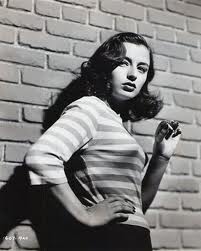
Just watched Il testimone (46), directed by Pietro Germi, which features a very impressive performance from Marina Berti, something of a forgotten diva from postwar Italian cinema.
Her actual name was Elena Maureen Bertolini, and she was born in London, of all places in 1924, although she returned to Italy with her family in 1936. Despite her place of birth, he seems to have been thoroughly Italian, though, and acted almost exclusively in Italian (or Italian shot) films, starting from around 1941, when actors were much in demand in Rome. In 1942 she was the female lead in Giacomo l’idealista, directed by Alberto Lattuada, an early melodrama in which she starred opposite Massimo Serato. She had another successe opposite Amedeo Nazzari in La femme de la montagne (43), before the Italian film industry collapsed in the later stages of the war. L’histoire d’une fauvette, for instance, was shot in 1943 but not released until 1945; and it was on this film she met actor Emilio Giordana, aka Claudio Gora, who she married the following year and subsequently had three children who would all go on to become actors, Andrea, Carlo and Marina Giordana.
Once the industry had begun to revitalise itself, she began appearing in numerous films, often opposite her husband. During the fifties, though, the nature of her roles began to change, from being a girlish love interest in the likes of Il testimone (46) to more of a character actress. Speaking perfect English, she was also a popular choice for international films shot at Cinecitta, including Deported (50), Quo Vadis (51), Ben Hur (58) and Cleopatra (63). She did appear in one film shot in America, Alexander Hall’s Up Front (51), based on the popular wartime cartoons, although she didn’t endear herself to the Hollywood machine when she refused to appear in a skimpy bathing suit for PR photos.
In the sixties and seventies, she was still extremely busy, with supporting parts in peplums (The Tyrant of Syracuse (62), gothic horrors (Un angelo per Satana, 66) and spaghetti westerns (Un uomo, un cavallo, una pistola (67), L’odio è il mio Dio (69)), amongst others. As the industry declined in the 80s, she was more regularly found on television, before making her last film in 2001, Amen, directed by Costa-Gavras. She died in October 2002 after a long illness, having spent over sixty years making films in Italy.
She’s not actually in CLEOPATRA. Her role is described as “QUEEN AT TARSUS”, but that must have been in a longer cut because there is no such role in the movie as it currently stands.
Ah, one of the many to have been cut out then!
Wonderful hot & romantic Marina Berti. The dying eternal goddess of Love in Quo Vadis !
„A more beautiful figure than hers even Skopas himself has not chiselled…That is simply a nymph,” …and ‘twas Venus who gave birth to her…“
“My jests do not prevent me from thinking at times that in truth there is only one deity, eternal, creative, all-powerful, Venus Genetrix. She brings souls together; she unites bodies and things…”
Sienkiewicz: Quo Vadis: A Narrative of the Time of Nero. 1896.